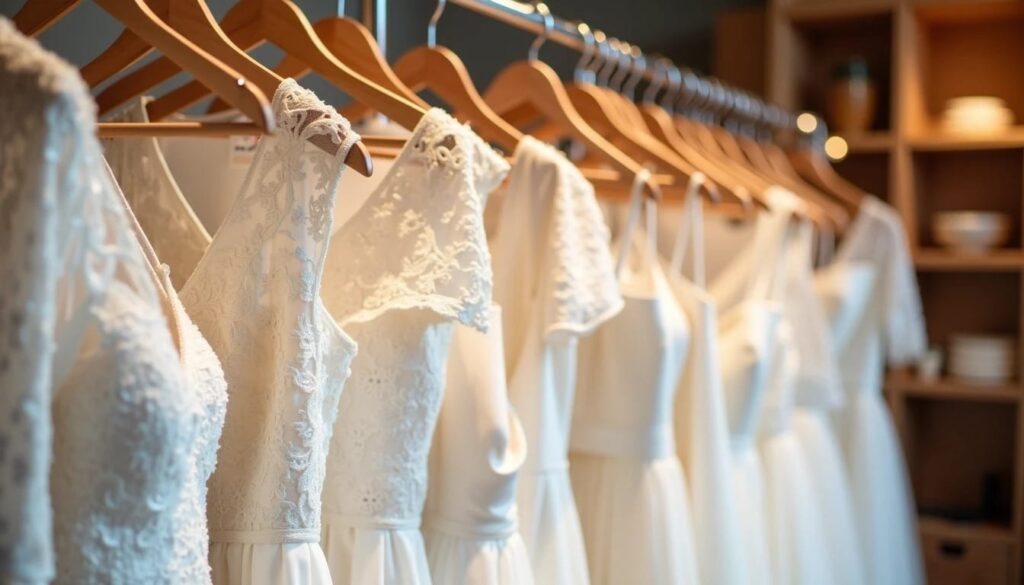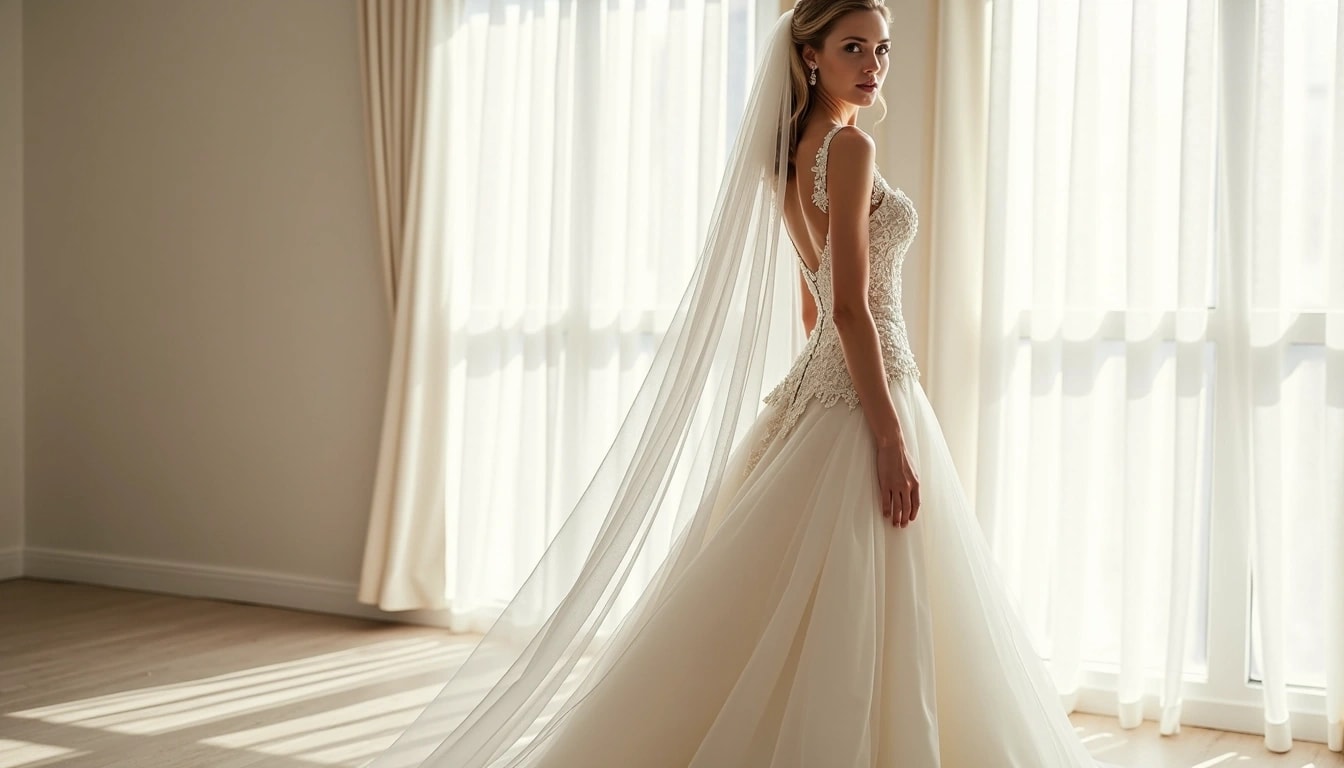Some wedding dresses look like they belong in a museum—and honestly, many of them should. However, the more detailed the dress, the harder it is to clean without damaging something important. We’re talking about dresses covered in tiny beads, fragile lace, layers of soft tulle, and even hand-painted fabrics. They’re beautiful, but they leave almost no room for mistakes when it’s time to clean them.
Not every cleaner knows how to handle a dress like that. Wedding dresses like these require a real expert—someone who understands how different fabrics react to cleaning, how hidden stains can cause problems later, and how to protect delicate details from falling apart.
Time isn’t on the side of a delicate dress. Invisible stains set fast, loose threads unravel, and fragile beads can break before you notice they’re gone. If your dress falls into any of these eight high-risk categories, don’t wait—find a true wedding dress specialist before permanent damage sets in.
1) Lace Covered Dresses
Lace is one of the most loved and most fragile fabrics in bridal fashion. From vintage veil overlays to full lace sleeves and bodices, it adds texture and romance to any wedding dress. But from a cleaner’s point of view, it’s a high-risk textile.
Lace is delicate, prone to snagging, and can absorb stains deep into the open weave. That means spot cleaning has to be done with precision—too aggressive, and the fibers fray or tear; too light, and the stain stays put. Plus, many lace fabrics are sewn over softer base materials like silk or tulle, so the cleaning method has to be compatible with multiple layers. For heavily laced dresses, especially those worn outdoors or during a humid wedding reception, gentle soaking and meticulous handwork are a must.
2) 100% Silk Dresses
Silk is the gold standard of bridal fabrics, but it’s also one of the hardest to clean. Natural silk is highly sensitive to water, heat, and many chemicals used in traditional dry cleaning. Even perspiration or body oil can cause discoloration or fabric weakening, especially around the underarms, bust, and back seams.
Silk dresses often need to be cleaned using pH-neutral solutions and air-dried flat to avoid puckering or water marks. And since silk doesn’t tolerate high heat, standard pressing or steaming is out of the question. In some cases, stain removal can actually lighten the silk in that area, creating visible “halo” marks. This is why cleaning of silk dresses should always be done by a specialist with experience in bridal dress cleaning, especially if you’re preserving it long term in a box or considering resale.
3) Heavily Beaded or Sequined Dresses
Beaded and sequined wedding dresses are dazzling, no doubt. But all those sparkles come at a price, especially when it’s time to clean them. These dresses are tricky because the embellishments are often hand-sewn, glued, or fastened with fragile threads that don’t hold up well to agitation or solvent exposure.
If even a few beads fall off during the process, it can create loose threads and unravel more detailing. Some cleaners remove embellishments before washing and reattach them afterward, which is an extremely time-consuming and costly task. Plus, some sequins (especially vintage) are made of gelatin or plastic that melts under heat. Cleaning these dresses requires handwork and a no-shortcuts approach, which makes them one of the top contributors to high bridal dress cleaning costs.
4) Multi-layered Tulle or Organza Dresses
Tulle and organza dresses are often full and ethereal, with dramatic skirts or delicate overlays that move beautifully in photos. But the downside is they’re incredibly sensitive to friction and prone to wrinkling, snagging, and even tearing during handling.
Cleaning multiple layers of these fabrics requires slow, methodical processing. You can’t throw them into any standard laundry setup, and even steaming must be done gently and from a distance to avoid warping. Any dirt or residue that ends up between the layers—like flower petals, soil, or makeup—has to be cleaned without damaging the shape or structure of the dress. These types of dresses often take the longest to prepare for bridal dress preservation because they need careful drying, reshaping, and repacking.
5) Vintage or Heirloom Dresses
Vintage dresses, especially those worn by family members in previous generations, bring their own set of cleaning complications. These dresses may feature outdated textile blends, deteriorated seams, oxidized paper tags, or mildew from decades in storage.
The challenge here is twofold: preserving the original integrity of the fabric and removing deep-set yellowing or discoloration. That often involves soaking, slow rinsing cycles, and very light handling. Older dresses can’t withstand the same tension or temperature levels as modern dresses. That means no machine cleaning, limited exposure to light, and a trained eye for identifying weak points in the fabric. Cleaning a 40-year-old bride’s dress is more like a restoration project than a traditional laundry job, and it takes museum-quality care.
6) Couture or Custom-made Dresses
Couture wedding dresses and custom-designed dresses are often the most expensive and least standardized pieces to clean. They combine fabrics like silk, lace, organza, and tulle into one dress—with unique stitching, embellishments, and linings that aren’t always labeled.
Because there’s usually no care label to reference, cleaners have to test each part of the dress for colorfastness, shrinkage risk, and reaction to different treatments. It’s essentially a garment-specific plan made from scratch. If the dress includes built-in structure like boning or corsetry, that adds another layer of complication. Custom-made dresses also tend to hold significant emotional value, so extra steps (including insurance and communication via email) are often built into the cleaning process. The stakes are higher, and so is the cost.
7) Dresses Worn at Outdoor Weddings
Beach, forest, vineyard, or garden weddings may look dreamy, but they leave wedding dresses with a whole set of issues. Dresses worn outdoors pick up debris and moisture from the environment, like mud, pollen, grass, sand, and dust. Most of this ends up embedded into the hem, train, and seams.
If the dress wasn’t cleaned right after the honeymoon, these contaminants can settle in and stain permanently. Sometimes, the stains aren’t even visible until the fabric starts to yellow or mildew. Depending on the length of the train and type of fabric, the entire lower portion may need to be soaked, scrubbed gently by hand, and air-dried to protect the integrity of the textile. Brides who are exposed to high humidity should especially avoid storing their dresses in plastic bags for long periods of time.
8) Dyed or Non-white Wedding Dresses
Colored wedding dresses—whether they’re blush, champagne, or full-on red or black—add a whole new level of cleaning complexity. These dresses are often custom-dyed, and the color can bleed or fade during standard cleaning methods. That’s a huge risk when mixing multiple fabrics or when cleaning a dress that includes both colored and white panels.
Professional cleaners must test the dyes before attempting to treat the fabric. Even eco-friendly or environmentally friendly methods can shift color if the dress isn’t prepared properly. It’s not just about stain removal, but rather about preserving the vibrancy and balance of color in the dress.
Preserve Every Detail of Your Wedding Dress—Contact Columbus Dry Cleaning & Laundry Services for Expert Cleaning and Preservation!

Find your dress on this list? Don’t worry—at Columbus Dry Cleaning & Laundry Services, we specialize in restoring and preserving even the most delicate, complex, and couture wedding dresses.
Our team goes beyond “standard dry cleaning.” We hand-inspect every layer, test for hidden stains, and customize a gentle treatment plan to protect lace, beadwork, sequins, and specialty fabrics. From silk ball gowns to modern minimalist designs, we safeguard the beauty and structure of your dress so it looks as breathtaking decades from now as it did on your wedding day.
📞 Call us today at 380-212-2298
📧 Email: info@columbuscleaning.com
🕒 Business Hours:
Monday–Friday: 7:30 AM – 6:00 PM
Saturday: 9:00 AM – 3:00 PM
Sunday: CLOSED




